Earth is often referred to as the Blue Planet, with water comprising 71% of its surface. However, just 0.5% of the earth’s water is available fresh water. (1) While many children have experienced the wonder of rivers, lakes, and wetlands, they might not recognize the value of these wild waters. This column dives into four Caldecott picture books that feature freshwater resources, precious and limited assets that sustain terrestrial life.

Author Carole Lindstrom (Anishinaabe/Métis) wrote We Are Water Protectors in response to the 2016 protest by the Standing Rock Sioux Tribe against the construction of the Dakota Access Pipeline. Also inspired by the solidarity of these protesters, illustrator Michaela Goade (Tlingit) immersed herself in the book project. Growing up in Southeast Alaska, where “Water is a way of life[,] … [the] core theme [of the book] really resonated.” (2) The artist renders her expressive paintings in watercolor, with some colored pencil and gouache detailing and digital edits. (3) Upon receiving the 2021 Caldecott Medal for her distinguished picture book, Goade became the first BIPOC woman and first Indigenous illustrator to be so honored. (4)
Goade contends that her favorite color is “Ocean,” (5) and the initial full-bleed double-page spread reflects this. Here we see our unnamed young protagonist and narrator, standing in the water with her Nokomis, or grandmother, and three other women, all water protectors. Melding realistic and surrealistic styles, the artist breathes life into the flowing water in a wide range of blue and aqua hues, balanced by golds, oranges, and rich reds on this page and throughout the book. In the background, one can see muted white trees and leaves, almost ghost-like. On the verso foreground, Goade has included woodland floral designs, inspired by Anishinaabe motifs often seen in beadwork. She repeats these techniques and designs on other spreads.
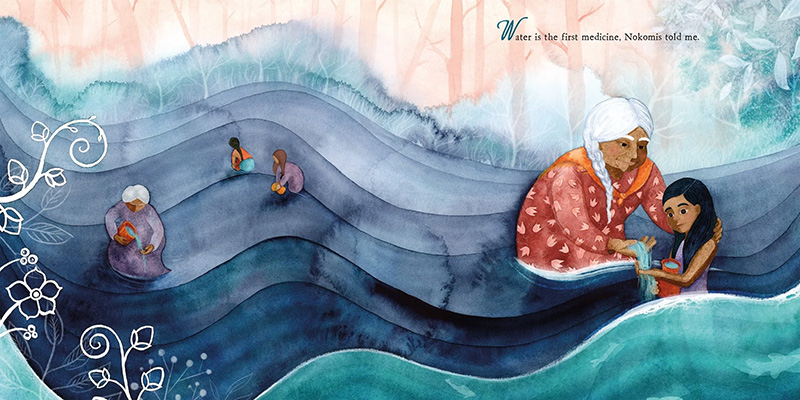
Following scenes of water, land, animals, and storytelling, with warnings of the arrival of a black snake, readers face a menacing full-page spread. Harsh rectangles represent the human-made oil pipeline, in sharp contrast to the curved lines and shapes of the natural world. The red and black colors are threatening. Indeed, in the lower verso, the snake is choking a plant. This is our narrator’s call, not just to observe and listen, but to act.
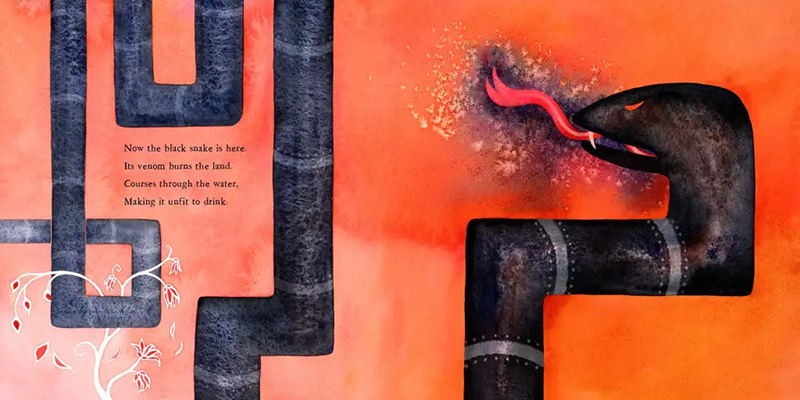
Two spreads later, the girl has transformed, wearing a traditional ribbon skirt, donning medicine wheel earrings, and holding a feather. Threats to the water have brought the girl and others to the land. The illustrator draws attention to the girl by positioning her in the forefront of the recto, arms outstretched and hair flowing in dynamic diagonal lines and a determined gaze off the page to the right. She is poised to lead.
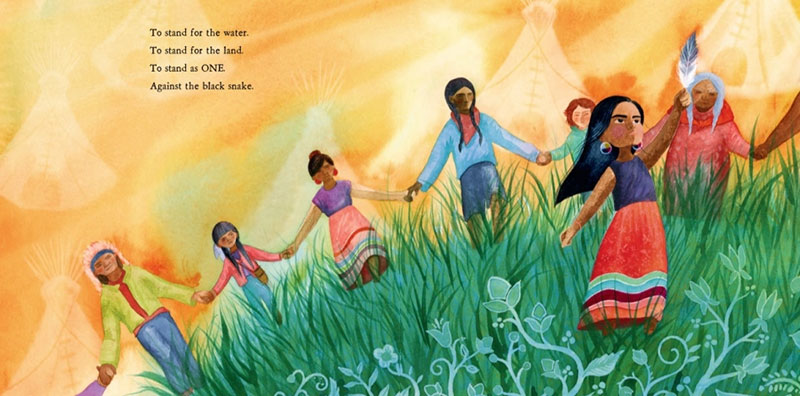
The book offers exclusively double-page spreads, except for three single page illustrations where the verso asserts the refrain “We stand | With our songs | And our drums. | We are still here.” As the story progresses, the number of people in that circle expands from five to eight. This circle calls attention to the cycle of life and mirrors other images in the book of the moon, sun, and earth. On the recto rests a turtle, a powerful figure in many indigenous creation stories, including the Anishinaabe’s Turtle Island. Cradled by our narrator, the turtle also serves as a bridge between water and land, reinforcing the spirit and strength of Standing Rock protestors.
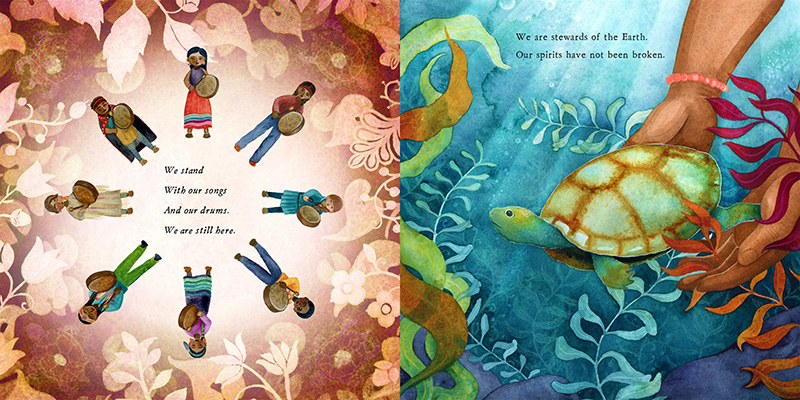
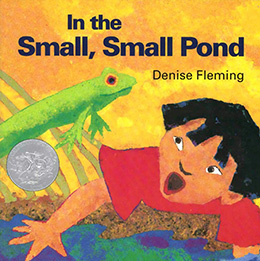
The interconnectedness of water and the life it sustains is also explored in Denise Fleming’s In the Small, Small Pond. In this 1994 Caldecott Honor book, the author-illustrator directs her attention to one small but diverse ecosystem. Readers are introduced to animals that reside in and around the pond, from turtles and geese to whirligigs and muskrats. Dynamic verbs describe their activities, as they waddle and doze, twirl and stack. The bold, sans-serif typeface is an important design element, with words in motion in every spread.
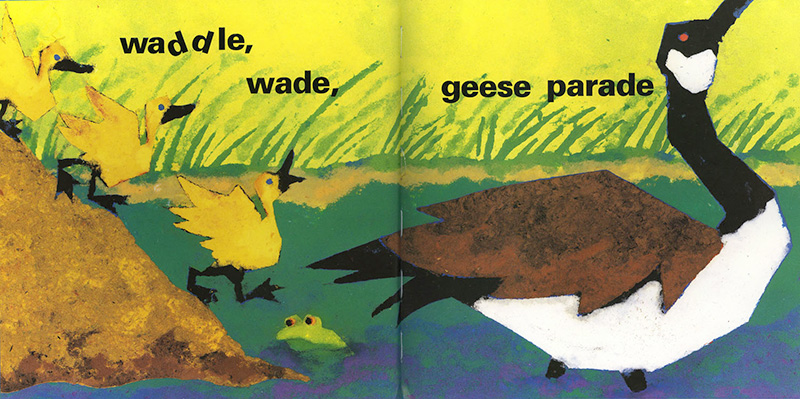
Witnessing the action and unifying the illustrations is a frog seen leaping, sitting, or swimming as it moves about from shore to water, sometimes evading danger.
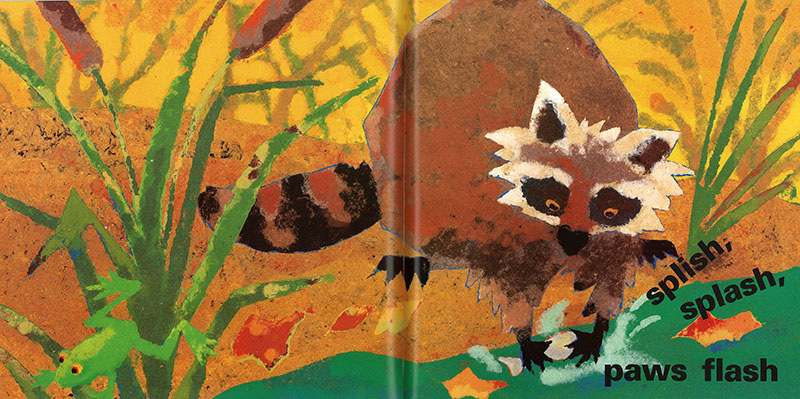
To heighten the drama, Fleming continually changes perspective. At times, readers are directly on shore, at water level, like the child on the cover and the first spread. In other images, readers are taken underwater or launched directly above the water to look down upon the scene.
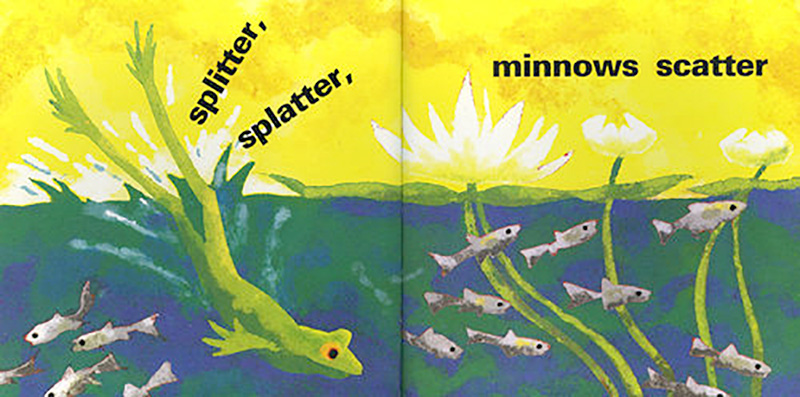
The story follows the pond through a year, beginning with tadpoles wriggling in the spring, and ending with the frog nestled in mud for the winter. Fleming effectively shows the changes in the seasons through her use of color from vibrant greens, yellows, and blues in the spring and summer, to muted hues in the fall and winter.

The artist creates her textured, abstract images through pulp painting, in which “Cotton rag fiber suspended in water (a wet, messy, colorful slurry) is poured through hand-cut stencils (made from foam meat trays) onto a screen (a window screen will do). The result — an image in handmade paper. The paper is the picture. The picture is the paper.” (6) This unusual water-intensive medium is appropriate to a story that spotlights pond life.
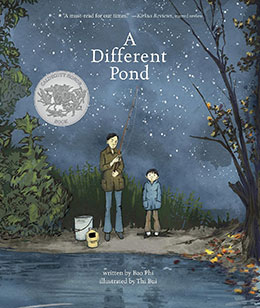
Among turtles and frogs, many ponds, lakes, and rivers provide habitat for fish. For some anglers, fishing is a recreational sport. However, for the Vietnamese American immigrant family portrayed in A Different Pond, fishing is a necessity. Written by Bao Phi and illustrated by Thi Bui, this 2018 Caldecott Honor book recounts an early morning fishing excursion of a father and son. “Hours before the sun comes up,” the two quietly leave the house, purchase bait at a local shop, and find their way to the banks of an urban river. (7)
The illustrator sets the mood with her palette of blue, grey, and brown hues, reflecting “the working class realities, the quiet sadness, and the understated resilience that really formed my values as a child growing up in immigrant America.” (8) While the father and child exchange few words on this chilly morning, a glow always surrounds them. Bui used watercolor brushes and sumi ink for the realistic drawings, then colored the images digitally. “[I]t was my first time attempting full color [picture book illustration], and I wanted more freedom to mess up and try different things than I would have had if I’d watercolored by hand. I still wanted the feeling of watercolor though, so I had several scans of ink washes I did that I added as an overlay texture.” (9) The range of values adds surprising detail and depth, imparting a sense of mystery.
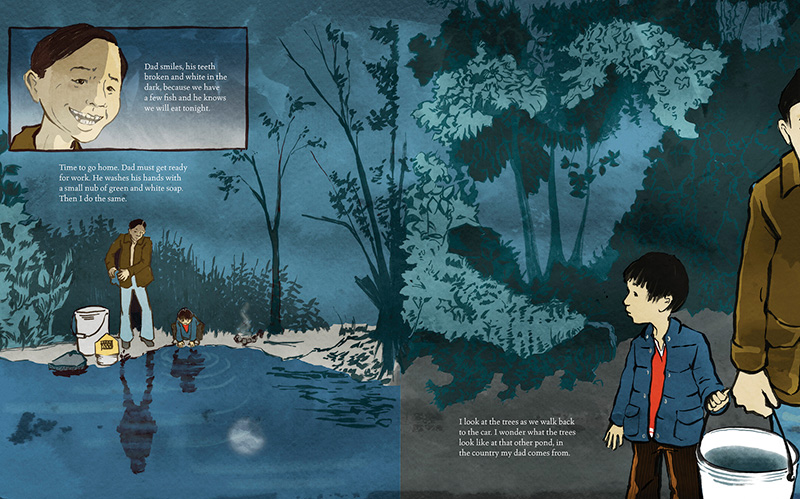
When the pair arrives home as daylight breaks, the palette of the interior images shifts to yellows and golds.
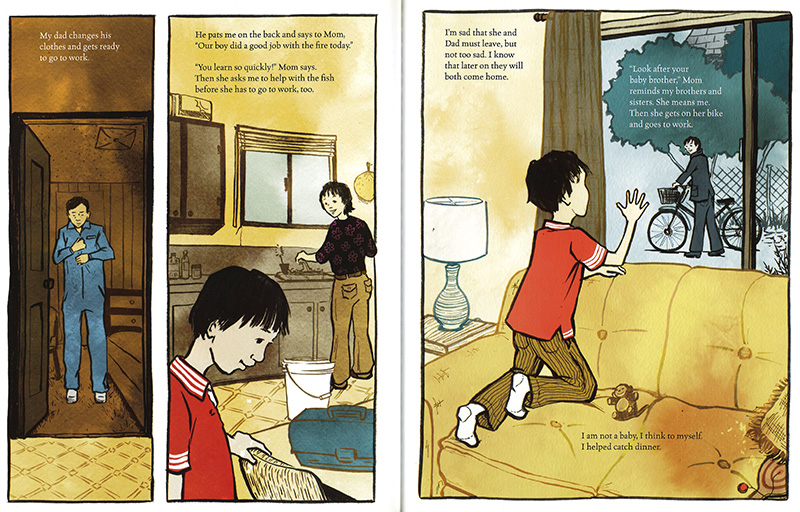
The page designs convey Bui’s comics background, such as her use of panels for the interior scenes. In contrast, exterior scenes are full-bleed single- or double-page spreads, many with inset panels, where one panel sits within a larger panel. In order to “allow the reader to both hear the inner voice of the main character and see the main character as he was,” (10) the illustrator shifts the point of view and sometimes incorporates more than one angle in a single spread, such as when the boy is setting up a fire or when the father catches a fish.
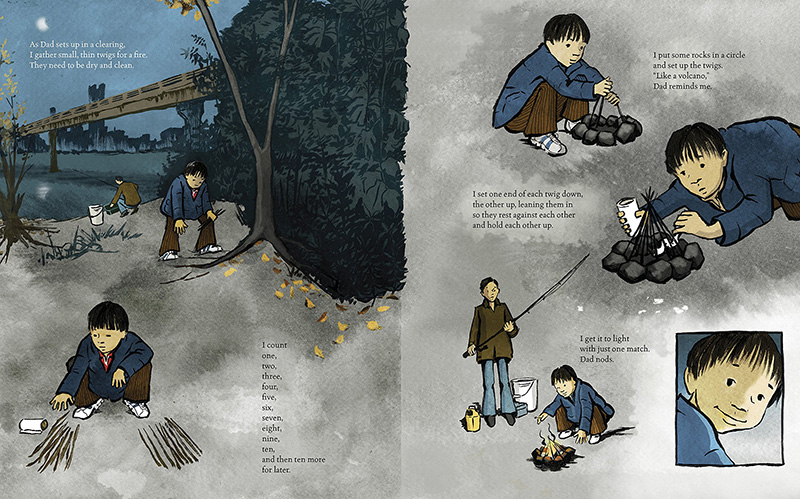
Throughout the book, however, Bui ensures that the boy is “the focal point of the art.” (11)
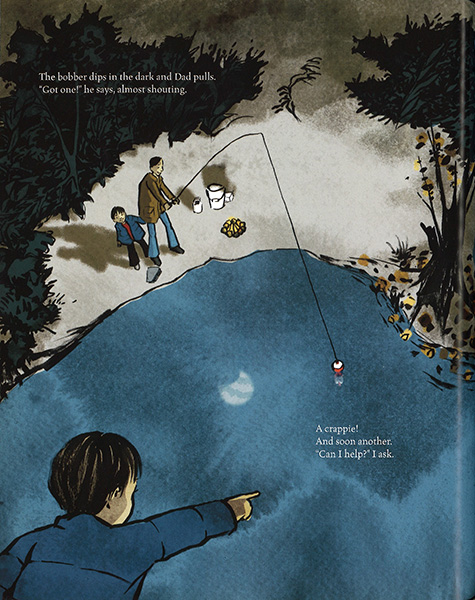
Both the author and illustrator were born in Vietnam and raised in the United States in the 1980s, when this story is set. The endpapers are filled with loose line drawings of childhood mementos and household items from that era, including an action figure, sneakers, multiple locks on a door, and fish sauce in a repurposed mayonnaise jar. Among the objects are a fishing reel and bobber, rekindling memories of a father and son fishing in the Midwest and of a different pond in Vietnam.
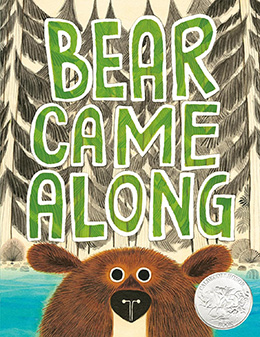
Diverging from a tender family moment into a humorous animal caper is the 2020 Caldecott Honor book Bear Came Along. Author Richard T. Morris and illustrator LeUyen Pham explore how encounters with the unexpected can ultimately lead to delight. A river “that didn’t know it was a river” is the catalyst for a bear’s expedition downstream on a log, picking up a frog, two turtles, a beaver, two raccoons, and a duck before calamity strikes.
Pham chooses a cartoon style to visually interpret the narrative. She explains that the book “was one of those rare stories that, the moment I read it, I knew exactly how it would look.” (12)
Her watercolor, ink, and gouache illustrations infuse the story with charm and humor. She uses a combination of full-bleed double- and single-page spreads, interspersed with panels, which help guide the pacing of the story. The artist also drops a visual clue before each new animal hops aboard. As the journey progresses, the backgrounds gradually change from muted greens and neutral tones to colorful shrubs and flowers amidst the greenery. Line work adds texture to fur, feathers, and plants, while circles and spirals decorate rocks and stir up the water.
The illustrator’s varied perspectives create excitement as the point of view moves between the surface of the river to aerial views. When the raccoons and duck join the group, the log is charging closer and closer to readers.
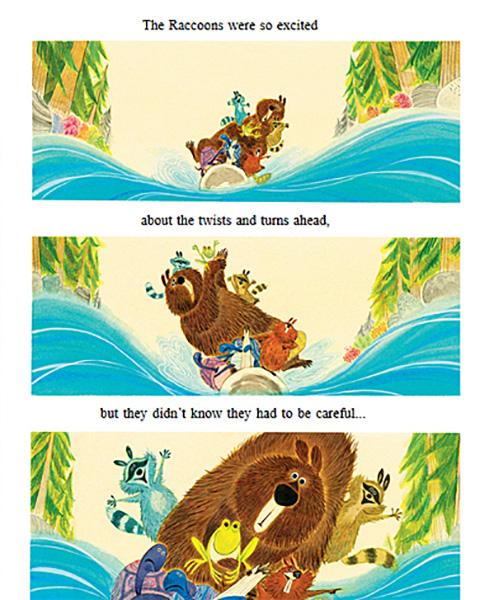
When they reach the edge of a waterfall, readers are on board the log to behold this alarming site; upon turning the page, readers are looking directly at the terrified crew.

For the great spill down the waterfall, Pham switches the orientation of the book for an especially long vertical shot of the mayhem.
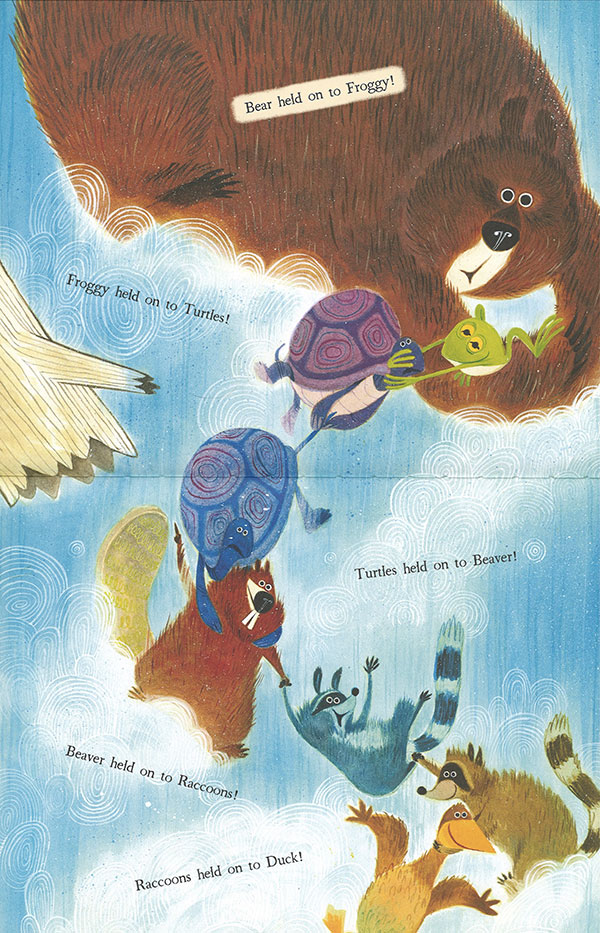
The final spread shows the adventurers resting and playing in the waters while a variety of mammals and birds watch from the shore, the landscape now in full color.
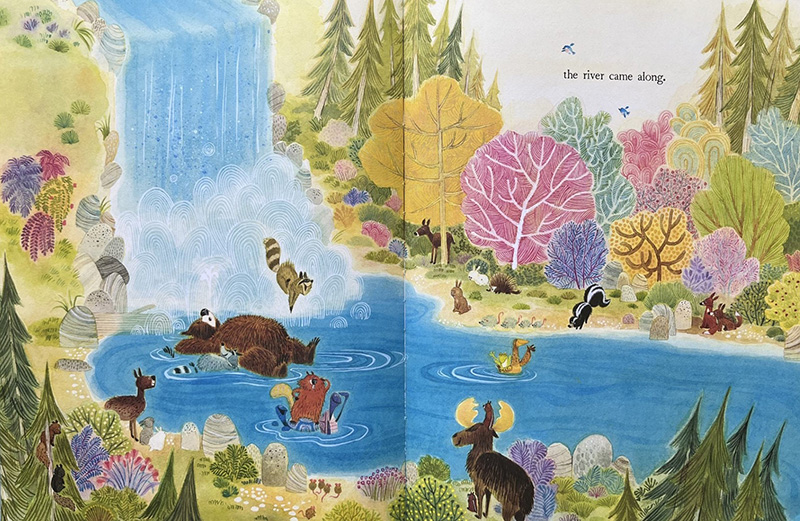
The tale is deceptively profound. In her Artist’s Note, Pham explains, “While painting this book, I spent a lot of time thinking about why people become divided from one another and forget that they all live on the same earth. It takes a small thing, like animals in a forest falling into a river, to realize this. We sink or swim together. And sometimes we take a tumble and things turn out all right.” (13)
In each of these Caldecott Award books, fresh water forges connections among the people or animals that depend on it. The picture books invite readers to become Water Protectors, observe wildlife, find nourishment, or discover adventure. As The Nature Conservancy upholds and these picture books convey, “rivers, lakes and wetlands are the hard-working systems that….feed communities, shape cultures and sustain the diversity of life on Earth.” (14) By engaging young readers through stories, adults have the opportunity to remind the next generation that “no resource on Earth is as valuable as fresh water.” (15)
Another Noteworthy Caldecott Freshwater Picture Book
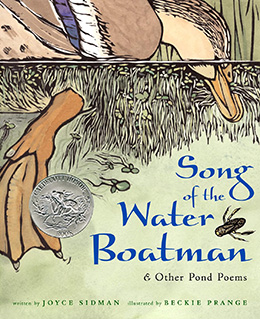 Sidman, Joyce. Song of the Water Boatman & Other Pond Poems. Illustrated by Beckie Prange. Boston: Houghton Mifflin Company, 2005. (2006 Caldecott Honor)
Sidman, Joyce. Song of the Water Boatman & Other Pond Poems. Illustrated by Beckie Prange. Boston: Houghton Mifflin Company, 2005. (2006 Caldecott Honor)
Picture Books Cited
Fleming, Denise. In the Small, Small Pond. New York: Henry Holt, 1993.
Lindstrom, Carole. We Are Water Protectors. Illustrated by Michaela Goade. New York: Roaring Brook, 2020.
Morris, Richard T. Bear Came Along. Illustrated by LeUyen Pham. New York: Little, Brown/Hachette, 2019.
Phi, Bao. A Different Pond. Illustrated by Thi Bui. North Mankato, MN: Capstone, 2017.
Notes
- “Water Facts — Worldwide Water Supply,” Bureau of Reclamation, Bureau of Reclamation, 4 November 2020.
- Erin McKinstry, “Finding Activism through Art: A Q&A with Tlingit Illustrator Michaela Goade,” KTOO, KTOO Public Media, 17 February 2021.
- Betsy Bird, “A Book That Demands Respect: Interviewing the Creators of We Are Water Protectors,” A Fuse #8 Production, School Library Journal, 28 April 2020.
- Kara Yorio, “A Grateful Michaela Goade Makes Caldecott History,” News & Features, School Library Journal, 25 January 2021.
- “About,” Michaela Goade, Michaela Goade, 4 February 2021.
- Denise Fleming, “Pulp Painting,” Papermaking, Denise Fleming, February 2018.
- Cathy Wurzer and Britt Aamodt, “Bao Phi on his Watching his Award Winning Children’s Book Come to the Stage in Hopkins,” Minnesota Now, Minnesota Public Radio, 18 October 2022.
- CAAM, “‘A Different Pond’’s Bao Phi and Thi Bui in Conversation,” CAAM, Center for Asian American Media, 20 February 2018.
- Mel Schuit, “Let’s Talk Illustrators #33: Thi Bui,” Let’s Talk Picture Books: Children’s Book Design & Illustration, Let’s Talk Picture Books, 25 July 2017.
- Mel Schuit.
- Mel Schuit.
- Christine Van Zandt, “Interview with Author-Illustrator LeUyen Pham,” Kite Tales, Society of Children’s Book Writers and Illustrators, 10 November 2021.
- Richard T. Morris, Bear Came Along, illustrated by LeUyen Pham (New York: Little, Brown, 2019).
- “Conserving Fresh Water for Life on Earth,” The Nature Conservancy, The Nature Conservancy, 2024.
- Giulio Boccaletti, “Water for Life,” The Nature Conservancy, The Nature Conservancy, 25 May 2017.
Bibliography
Read or download the Bibliography as a PDF.

WOW!